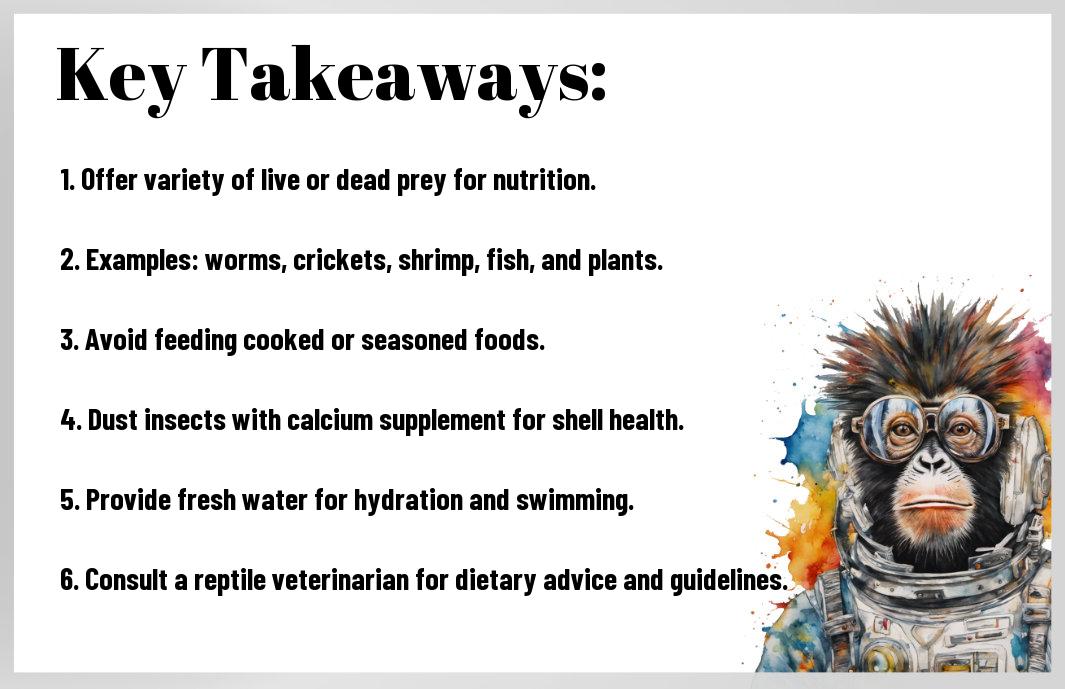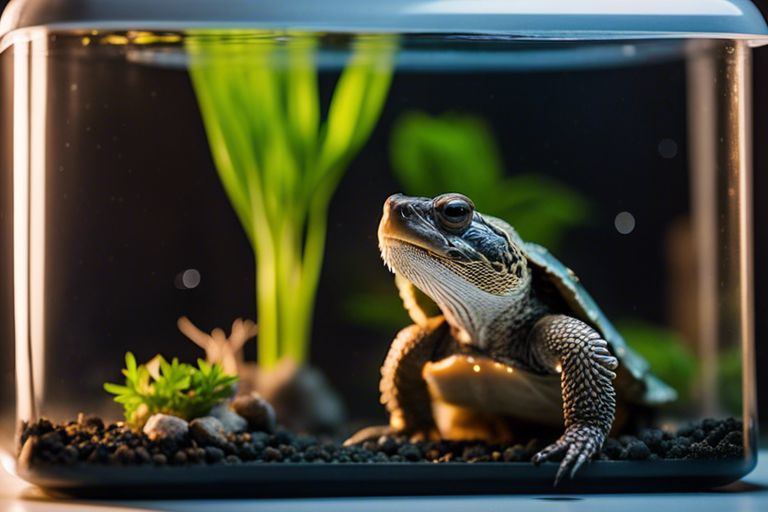Feeding a baby snapping turtle requires careful consideration to ensure its health and growth. These unique creatures have specific dietary needs that must be met to thrive in captivity. Providing the right foods is essential to prevent nutritional deficiencies and ensure a strong immune system. Avoiding improper foods is crucial as it can lead to serious health issues and even death. By offering a balanced diet of live prey and commercial turtle pellets, you can help your baby snapping turtle develop into a healthy adult.
Key Takeaways:
- Offer a varied diet: Baby snapping turtles should be fed a variety of foods to ensure they receive all the necessary nutrients for growth and development.
- Include protein sources: Include protein-rich foods such as worms, insects, small fish, and commercial turtle pellets in their diet to support their muscle and shell development.
- Avoid feeding human food: Do not feed baby snapping turtles human food as it may not provide the essential nutrients they need and could potentially harm them.

Natural Diet of Snapping Turtles
The natural diet of snapping turtles primarily consists of aquatic vegetation, insects, small fish, frogs, snakes, and even small birds or mammals. They are opportunistic feeders and will consume a wide variety of prey depending on what is available in their environment.
Snapping turtles are known to be scavengers, feeding on carrion and decaying matter as well. Their powerful jaws and sharp beaks allow them to easily crush shells and tough prey, making them efficient predators in their habitat.
Comparison with Adult Snapping Turtle Diets
To understand what to feed a baby snapping turtle, it is essential to compare their diet with adult snapping turtles. While adult snapping turtles have a similar diet of aquatic vegetation, insects, fish, and other small animals, they may consume larger prey due to their size and strength.
| Baby Snapping Turtles | Adult Snapping Turtles |
| Feed on smaller insects and fish | Can consume larger prey like ducks or small mammals |
| Require more frequent feeding | Can go for longer periods without food |
Wild vs. Captive Dietary Considerations
Diet plays a crucial role in the health and development of baby snapping turtles, whether they are in the wild or in captivity. In the wild, baby snapping turtles have access to a variety of prey and natural foods that help provide a well-rounded diet.
Diets in captivity should mimic their wild diet as closely as possible to ensure they receive the necessary nutrients for growth and development. Care should be taken to provide a balanced diet that includes a mix of protein sources, vegetables, and calcium supplements to promote healthy shell and bone development.
Feeding Schedule and Quantity
Not sure how often and how much to feed your baby snapping turtle? In this chapter, we will provide guidance on establishing a feeding schedule and determining the right quantity of food for your little reptile.
Determining the Right Amount to Feed
To ensure your baby snapping turtle is getting the proper nutrition without overfeeding, it’s essential to consider its size and age. A good rule of thumb is to offer food that is roughly the size of the turtle’s head. This ensures that the meal is manageable and prevents the risk of choking. Overfeeding can lead to obesity and health issues in snapping turtles, so it’s crucial to portion out their meals carefully.
Another way to determine the right amount to feed is by monitoring your turtle’s behavior. If it consistently leaves food uneaten or appears disinterested in eating, you may be offering too much. Adjust the portion size accordingly to avoid wastage and keep your turtle healthy.
Frequency of Feedings for Optimal Health
With baby snapping turtles, it’s crucial to strike a balance between providing enough nutrition for growth and development and not overwhelming their digestive system with too many feedings. Typically, offering food once a day is sufficient for young turtles. As they grow, you can adjust the frequency to every other day to accommodate their changing dietary needs.
The key is to observe your turtle’s behavior and adjust the feeding schedule accordingly. Consistency is key for their health and well-being, so try to establish a routine that works best for both you and your baby snapping turtle.
Suitable Foods for Baby Snapping Turtles
Despite their small size, baby snapping turtles require a varied diet to ensure they receive adequate nutrition for healthy growth. Providing a balanced mix of live food options and commercial or prepared foods is essential for their development.
Live Food Options
Options for live foods for baby snapping turtles include small insects like crickets, mealworms, and waxworms. These insects are high in protein and essential nutrients that are crucial for the turtle’s growth and development. Additionally, aquatic plants like duckweed and water lettuce can be added to their diet to provide fiber and essential vitamins.
It’s important to offer a variety of live foods to ensure that the baby snapping turtle receives all the necessary nutrients for their well-being. Live foods should be gut-loaded with nutritious foods or dusted with a calcium supplement before being fed to the turtle to prevent nutritional deficiencies.
Commercial and Prepared Foods
On the other hand, commercial turtle pellets and prepared foods are convenient options for feeding baby snapping turtles. These foods are specially formulated to meet the dietary needs of turtles and are often enriched with essential vitamins and minerals. Commercial foods provide a balanced diet and are an easy way to ensure that your turtle is getting all the necessary nutrients.
Snapping turtles may have a preference for live foods, but introducing commercial foods from an early age can help them get used to a varied diet. It is essential to choose high-quality commercial foods to ensure the health and well-being of your baby snapping turtle.
Common Feeding Mistakes and How to Avoid Them
Overfeeding and Its Consequences
Unlike other pets, baby snapping turtles should not be fed every day. Overfeeding can lead to various health issues for your turtle. One common consequence of overfeeding is obesity, which can put a strain on the turtle’s organs and lead to a shorter lifespan. Additionally, overfeeding can cause shell deformities and digestive problems.
Feeding a baby snapping turtle too much can also result in excess waste production, leading to poor water quality in their habitat. It is important to establish a feeding schedule and monitor your turtle’s weight to ensure they are growing at a healthy rate.
Nutritional Deficiencies and Imbalances
Feeding your baby snapping turtle a diet that lacks variety can result in nutritional deficiencies and imbalances. Turtles require a balanced diet that includes a mix of protein, vegetables, and calcium sources. Neglecting to provide these essential nutrients can lead to stunted growth, weakened immune system, and shell deformities.
Consequences of nutritional deficiencies in baby snapping turtles can be severe and irreversible. It is crucial to research and understand the dietary needs of your turtle to prevent these issues from occurring.
Feeding your baby snapping turtle a varied diet that includes insects, leafy greens, and calcium supplements will help ensure they receive all the essential nutrients for healthy growth. Remember to consult with a veterinarian or reptile specialist for specific dietary recommendations tailored to your turtle’s needs.
Health and Growth Monitoring
Keep a close eye on the health and growth of your baby snapping turtle to ensure it is thriving in its environment. Monitoring these aspects regularly will help you identify any potential issues early on and take the necessary steps to address them.
Recognizing Signs of Good Nutrition
Growth: A healthy baby snapping turtle should exhibit steady growth over time. Keep track of its size and weight to ensure it is developing properly. A well-fed turtle will have a sturdy shell and vibrant skin color.
Activity Level: An active and alert turtle is a good sign of proper nutrition. Monitor your turtle’s behavior and make sure it is engaging in its natural activities such as swimming, basking, and exploring its environment.
When to Consult a Veterinarian
Growth: If you notice any stunted growth or abnormalities in your baby snapping turtle’s development, it is crucial to seek veterinary advice promptly. A veterinarian specializing in reptiles can assess the turtle’s health and provide recommendations for improvement.
Nutrition: If your baby snapping turtle shows signs of malnutrition despite your best efforts, such as refusing to eat or showing lethargy, it is imperative to consult a veterinarian. They can offer guidance on adjusting its diet or provide medical treatment if necessary.
It is essential to proactively monitor the health and growth of your baby snapping turtle to ensure it is receiving adequate nutrition and thriving in captivity. Regularly observing its behavior, growth patterns, and overall appearance will help you detect any issues early on and take appropriate action to address them.

Conclusion
Taking this into account, the best diet for a baby snapping turtle consists of a balanced mix of protein, fruits, vegetables, and calcium supplements. Ensuring that it receives the proper nutrients is essential for its growth and development. By following these guidelines, you can help your baby snapping turtle thrive and lead a healthy life.





Leave a Reply